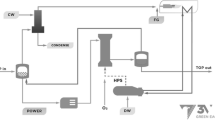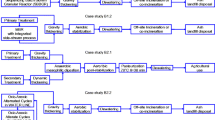Abstract
Today, several technologies and management strategies are proposed and applied in wastewater treatment plants (WWTPs) to minimise sludge production and contamination. In order to avoid a shifting of burdens between different areas, their techno-economic and environmental performance has to be carefully evaluated. Wet oxidation (WO) is an alternative solution to incineration for recovering energy in sewage sludge while converting it to mostly inorganic residues. This paper deals with an experimentation carried out within the EU project “ROUTES”. A mass balance was made for a WWTP (500,000 person equivalents) in which a WO stage for sludge minimisation was considered to be installed. Both bench- and full-scale test results were used. Design of treatment units and estimation of capital and operational costs were then performed. Subsequently, technical and economic aspects were evaluated by means of a detailed methodology which was developed within the ROUTES project. Finally, an assessment of environmental impacts from a life cycle perspective was performed. The integrated assessment showed that for the specific upgrade considered in this study, WO technology, although requiring a certain increase of technical complexity at the WWTP, may contribute to environmental and economic advantages. The paper provides guidance in terms of which aspects need a more thorough evaluation in relation to the specific case in which an upgrade with WO is considered.







Similar content being viewed by others
References
Abe N, Tang YQ, Iwamura M, Ohta H, Morimura S, Kida K (2011) Development of an efficient process for the treatment of residual sludge discharged from an anaerobic digester in a sewage treatment plant. Bioresource Technol 102:7641–7644
Baroutian S, Smit AM, Gapes DJ (2013) Relative influence of process variables during non-catalytic wet oxidation of municipal sludge. Bioresource Technol 148:605–610
Bertanza G, Canato M, Laera G, Tomei M C (2014a). Method for technical and economic assessment of advanced sludge processing routes. Accepted for publication inEnvironmental Science and Pollution Research
Bertanza G, Galessi R, Menoni L, Pedrazzani R, Salvetti R, Zanaboni S (2014c) Anaerobic treatability of liquid residue from wet oxidation of sewage sludge. Accepted for publication inEnvironmental Science and Pollution Research
Bertanza G, Galessi R, Menoni L, Salvetti R, Slavik E, Zanaboni S (2014b). Wet oxidation of sewage sludge: process modeling and full scale experience, Accepted for publication inEnvironmental Science and Pollution Research
Bhargava SK, Tardio J, Prasad J, Föger K, Akolekar DB, Grocott SC (2006) Wet oxidation and catalytic wet oxidation. Ind Eng Chem Res 45:1221–1258
Collado S, Laca A, Diaz M (2012) Decision criteria for the selection of wetoxidation and conventional biological treatment. J Environ Manage 102:65–70
Corominas L, Foley J, Guest JS, Hospido A, Larsen HF, Morera S, Shaw A (2013) Life cycle assessment applied to wastewater treatment: state of the art. Water Res 47(15):5480–5492
Debellefontaine H, Chakchouk M, Foussard JN, Tisso D, Striolo P (1996) Treatment of organic aqueous wastes, wet air oxidation and wet peroxide oxidation. Environ Pollut 92(2):155–164
Debellefontaine H, Crispel S, Reilhac P, Perie F, Foussard JN (1999) Wet air oxidation (WAO) for treatment of industrial wastewater and domestic sludge. Design of bubble column reactors Chem Eng Sci 54:4953–4959
Debellefontaine H, Foussard JN (2000) Wet air oxidation for the treatment of industrial wastes. Chemical aspects, reactor design and industrial applications in Europe. Waste Manage 20:15–25
Devlin HR, Harris IJ (1984) Mechanism of the oxidation of aqueous phenol with dissolved oxygen. Ind Eng Chem Fundam 23:387–392
Duprez D, Delanoe F, Barbier J Jr, Isnard P, Blanchard G (1996) Catalytic oxidation of organic compounds in aqueous media. Catal Today 29:317–322
Europe’s energy portal: http://www.energy.eu/. Accessed 03rd March 2014
European Commission Joint Research Centre (2010) ILCD Handbook—International Reference Life Cycle Data System. First edn. European Union. doi:10.2788/38479
Foladori P, Andreottola G, Ziglio G (2010) Sludge reduction technologies in wastewater treatment plants. IWA Publishing, London
Foussard JN, Debellefontaine H, Besombes VJ (1989) Effective elimination of organic liquid wastes: wet air oxidation. Environ Eng 115:367
Gielen G, Love S, Lei R, Gapes D, Strong J, McGrouther K, Stuthridge T (2011) Wet oxidation technology—a potential biosolids management alternative, IPENZ Transactions 2011/2
Hii K, Baroutian S, Parthasarathy R, Gapes D, Eshtiaghi N (2014) A review of wet air oxidation and thermal hydrolysis technologies in sludge treatment. Bioresource Technol 155:289–299
Hurwitz E, Dundas WM (1960) Wet oxidation of sewage sludge. Water Pollut Control 32(9):918–929
Jaroslaw M, Roman Z (2008) Analysis of wet oxidation process after initial thermohydrolysis of excess sewage sludge. Water Res 42:3025–3032
Joglekar HS, Samant SD, Joshi JB (1991) Kinetics of wet oxidation of phenol and substituted phenols. Water Res 25(2):135–145
Khan Y, Anderson GK, Elliott DJ (1999) Wet oxidation of activated sludge. Water Res 33(7):1681–1687
Kroiss H (2004) What is the potential for utilizing the resources in sludge? Water Sci Technol 49:1–10
Larsen HF, Hansen PA, Boyer-Souchet F (2010) NEPTUNE—New sustainable concepts and processes for optimization and upgrading municipal wastewater and sludge treatment, Work Package 4—assessment of environmental sustainability and best practice. Deliverable 4.3 - Decision support guideline based on LCA and cost/efficiency assessment. pp. 163
Liu Y, Tay JH (2001) Strategy for minimization of excess sludge production from the activated sludge process. Biotechnol Adv 19:97–107
Luck F (1999) Wet air oxidation, past, present and future. Catal Today 53:81–91
Mahmood T, Elliott A (2006) A review of secondary sludge reduction technlogies for the pulp and paper industry. Water Res 40:2093–2112
Mishra VS, Mahajani VV, Joshi JB (1995) Wet air oxidation. Ind Eng Chem Res 34:2–48
Padoley KV, Tembhekar PD, Saratchandra T, Pandit AB, Pandey RA, Mudliar SN (2012) Wet air oxidation as a pretreatment option for selective biodegradability enhancement and biogas generation potential from complex effluent. Bioresource Technol 120:157–164
PE International (2013) Gabi Professional database 6
Pérez-Elvira SI, Nieto Diez P, Fdz Polanco F (2006) Sludge minimisation technologies. Rev Environ Sci Biotechnol 5:375–398
Ploos van Amstel JJA, Rietema K (1973) Wet-air oxidation of sewage sludge part II: the oxidation of real sludges. Chem Ing Tech 45:1205–1211
Ploos van Amstel JJAP (1971) The oxidation of sewage sludge in the liquid water phase at elevated temperatures and pressures (wet-air oxidation). PhD thesis, Eindhoven University of Technology, Netherlands
ROUTES - Novel processing routes for effective sewage sludge management: http://eurotes.org/index.php?option=com_content&view=article&id=50&Itemid=28. Accessed 03rd March 2014.
Schmidt AS, Thomsen AB (1998) Optimization of wet oxidation pretreatment of wheat straw. Bioresource Technol 64(2):139–151
Seiler GS (1987) Twenty five years of sludge management by wet oxidation. Sludge Manage Ser 17:100–105
Slavik E, Galessi R, Salvetti R, Bertanza G (2013) Experiences of sludge treatment by wet oxidation. In: Effective sewage sludge management—minimization, recycling of materials, enhanced stabilization, disposal after recovery, CNR Quaderni de “La Ricerca Scientifica” n. 120 – ISBN: 978-88-8080-113-9, p 111–130
Strehlenert RW (1911) Swedish Patent 34, 941
Strong PJ, Gapes DJ (2012) Thermal and thermo-chemical pre-treatment of four waste residues and the effect on acetic acid production and methane synthesis. Waste Manage 32:1669–1677
Strong PJ, McDonald B, Gapes DJ (2011) Combined thermochemical and fermentative destruction of municipal biosolids: a comparison between thermal hydrolysis and wet oxidative pre-treatment. Bioresource Technol 102(9):5520–5527
Stüber F, Font J, Fortuny A, Bengoa C, Eftaxias A, Fabregat A (2005) Carbon materials and catalytic wet air oxidation of organic pollutants in wastewater. Top Catal 33(1–4):3–50
Svanström M, Bertanza G, Bolzonella D, Canato M, Collivignarelli C, Heimersson S, Laera G, Mininni G, Peters G, Tomei MC (2014) Method for technical, economic and environmental assessment of advanced processing routes, accepted for publication (feb 7th, 2014) in Water Sci Technol
Tomei MC, Carucci A, Ramadori R, Rossetti S (1994) Validation of “ASCAM” model for biological nitrogen removal. In: Horan Nutrient NJ (ed) Removal from wastewaters. Technomic Publishing Company Inc., USA, pp 143–149
Tomei MC, Di Pinto AC and Ramadori R (1990) ASCAM: A simplified model for biological nitrogen removal. Proceedings of the IAWPRC 15th Biennial International Conference, Kyoto, 26th July–3rd August, 449–452
Wei Y, Van Houten RT, Borger AR, Eikelboom DH, Fan Y (2003) Minimization of excess sludge production for biological. Water Res 37:4453–4467
Yang X, Wang X, Wang L (2010) Transferring of components and energy output in industrial sewage sludge disposal by thermal pretreatment and two-phase anaerobic process. Bioresource Technol 101:2580–2584
Zerva C, Peschos Z, Poulopoulos SG, Philippopoulos CJ (2003) Treatment of industrial oily wastewaters by wet oxidation. J Hazard Mater 97:257–265
Zimmermann FJ (1958) New waste disposal process. Chem Eng 25:117–120
Acknowledgments
This project has received funding from the European Union’s Seventh Programme for research, technological development and demonstration under grant agreement no. 265156.
Author Contibutions
All authors participated with text in relation to their contribution to the study: Giorgio Bertanza and Matteo Canato carried out the techno-economic assessment. Giuseppe Laera was responsible for mass balance calculations. Sara Heimersson and Magdalena Svanström carried out the environmental assessment. Roberta Salvetti and Edoardo Slavik conducted WO full-scale tests and calculated capital and operating costs of the WO unit.
Author information
Authors and Affiliations
Corresponding author
Additional information
Responsible editor: Bingcai Pan
Rights and permissions
About this article
Cite this article
Bertanza, G., Canato, M., Heimersson, S. et al. Techno-economic and environmental assessment of sewage sludge wet oxidation. Environ Sci Pollut Res 22, 7327–7338 (2015). https://doi.org/10.1007/s11356-014-3378-6
Received:
Accepted:
Published:
Issue Date:
DOI: https://doi.org/10.1007/s11356-014-3378-6




